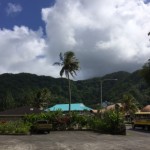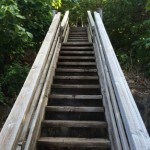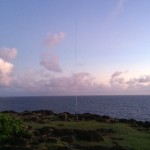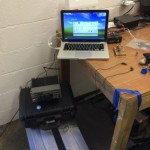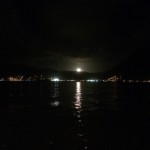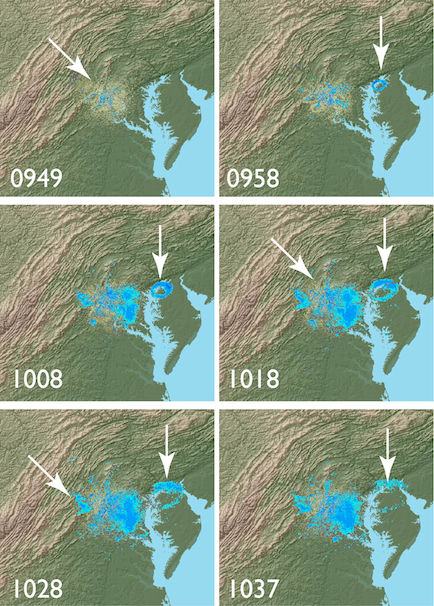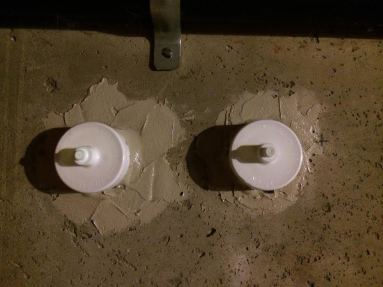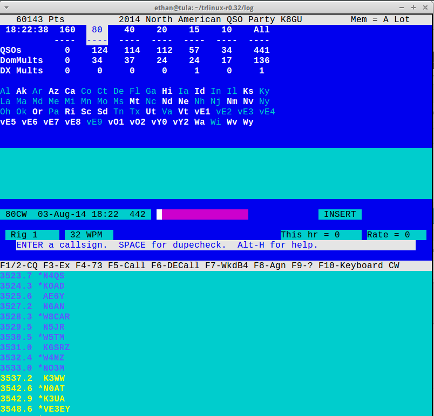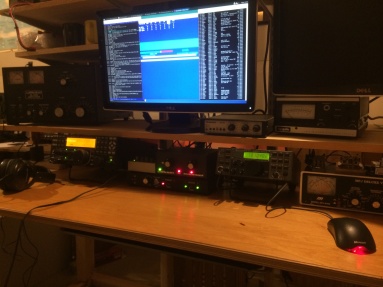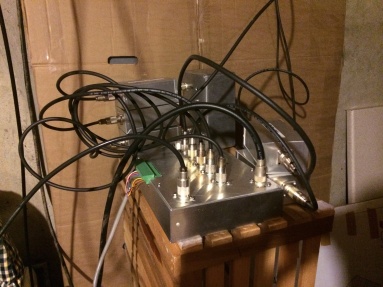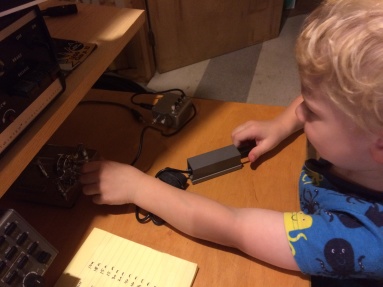Author Archive
 January Phase Noise
January Phase Noise
Radio activity around here was asymptotically approaching zero until this past weekend when I managed to put about two hours into the ARRL January VHF contest. In brief, here’s what’s happening around K8GU:
- 47Q x 17G on 6 (8/2), 2 (29/11), and 432 (10/4) in ARRL January VHF. The 6-meter QSOs were all made with an HF antenna. I ran 100 watts on 432 so I’m ineligible for the 3-band category. Heard, but didn’t work, N1GC (EM59), K1TEO (FN31, whom I almost always work), and VE3??? (FN03, I had the whole call at the time but forgot, working K1RZ).
- I did not work EP6T on any bands and really don’t care. I didn’t hear much of the jamming when I did listen (on 40 and 80). To paraphrase KE9V quoting JA1NUT, “I’m kind of over DXing.” Who has time for this, anyway?
- Speaking of the seedy underbelly of DXing…do you know what a “QSL grubber” is? I’ve experienced a couple of different variations on this in the past year and it’s disturbing. One guy was asking about specific QSOs and provided detailed description of (my) signal characteristics. Nevermind the fact that I never operated on the band he mentioned during that operation. He sent similar e-mail to several friends. As if DX operators don’t talk to each other? The DXCC desk has been notified. I wonder if anybody actually falls for it or gives in, though?
- I made token efforts in NAQP CW and Phone to chalk up a participation multiplier for PVRC in the three-way PVRC-SMC-NCCC competition.
- No homebrewing or repair work has been undertaken since the summer.
- The baby can crawl and wants to walk so badly she can’t stand it. The end is near.
- I took Evan to the Odenton Hamfest on Sunday morning. The highlight for him was stopping for donuts…and stopping at a playground on the way home. Bought some Snap-N-Seal F-type compression connectors for a work project, part of my quest to find the perfect F-connector for the perfect RG-6 type cable (quad-shielded, flooded). More on this in a future post.
- It seems there are plenty of Elecraft K2’s on the market these days. As the price slips below 1000 USD for a loaded K2/100, this radio is becoming a good buy. As a secondary note, they all seem to be “professionally constructed by a well-known builder.” This leads me to wonder what fraction of K2s were built by someone other than the owner (I estimated this fraction once to be about 1/3 of them). I also wonder if people who built their own K2s hold onto them longer?
And so it goes, time to punch my card…
 Signal and Noise
Signal and Noise
“One man’s signal is another man’s noise,” began Dr. Kudeki as he derived incoherent scatter radar theory from Nyquist’s noise theorem in ECE458. I think of that statement often, whether it be QRM on the ham bands or sifting through the pocket litter of web users looking for their consumption preferences.
This morning, I admired just such an example of signal and noise while watching the NOAA Doppler weather radar. Undesired targets of a radar that return echoes are termed “clutter” in the radar parlance and one simplistic way of eliminating clutter, especially when you expect the desired scatterers (“targets”) to move, is to assume that all of the stationary returns are clutter. In the weather radar, we get clutter from all sorts of stationary things like trees, hills, and buildings. Of course, what causes the clutter to move?
You see, it was one of those humid August mornings when a ham’s mind wanders to…tropospheric ducting. Yes, indeed the clutter returns were moving, intensifying before and after sunrise. I was fixated on this and watched the loop over and over again before noticing an even more interesting bit of clutter!
Beginning at 0958 UT on 4 August 2014, there is a small ring forming out over the Elk River area. The ring, which is indicated by the downward-pointing vertical arrows, expanded over the next >40 minutes. I was puzzled and watched the loop over and over. I considered and discarded a number of theories before resorting to Google. Apparently, it’s very likely a flock of birds. Sure enough, the epicenter of the ring is Elk Neck State Park. Fascinating.
The slanted arrows in the figure above indicates the ground clutter that I was originally noticing as a signature of tropo ducting, obviously now of secondary interest in this sequence of images!
Epilogue: I sent these frames to my father, who is an avid observer of the natural world. He passed them along to two friends back home who are birders. At press time, one reported that he had learned of these “bird circles” from Greg Miller, another birder from the area who got famous as one of the subjects of the book (and movie of the same title) The Big Year. I haven’t read/seen it, but I guess they went to Adak, which has a special place in my heart. Anyhow, it’s a funny small and interesting world in which we live.
 Notes and Ramblings
Notes and Ramblings
Three perhaps noteworthy amateur radio activities occurred recently around K8GU: 1. During the course of some HVAC upgrades, I was able to get two holes core drilled through the foundation to bring coax and control cables into the house; 2. I operated in the NAQP August CW contest; 3. Evan and I went to the Berryville, VA, hamfest.
These two ports exit the basement into a crawl space where I will ground the cables before they enter the house. I still need to get some hydraulic cement or other quick-setting patch mortar to clean up the drill crater on the outside. Total cost: $5 in materials and a large pizza for the crew.
Screenshot above shows TRLinux after the end of the contest (obviously it was today, not last night). TRLinux performed flawlessly again with the YCCC SO2R+ box driving the KK1L band-decoder and 6×2 switch. I operated for about five hours (probably a little more, and definitely more if I used the NAQP 30-minute time-off rule to calculate it). I got up after my first operating sitting at the beginning of the contest and left the shack. As I exited the door, I was hit with the smell of hot electronics. You know the smell: like when you just let the smoke out of a transistor. I walked over to the antenna switch matrix where I was using a triplexer to split the hexagonal beam to both radios. It was warm to the touch. It seems to have continued to function, but I’ll have to disassemble it at some point to see if any irreversible damage was done.
The August NAQPs are always fun for us out East because there is the ever-present opportunity for sporadic-E throughout the contest, giving us a chance to work nearby states, which can really drive up the multiplier (and QSO, depending on the direction of the opening) total. Of course, this is the real boon of having a second radio: you can call CQ on your most productive band while looking for openings on the others. I came down after supper with the family to “work 40 meters before it goes long” and ended up with blistering 10- and 15-meter runs into the Midwest and South. Since Evan and I were planning to go to the hamfest and I don’t yet have a 160-meter antenna at the “new” QTH, I pulled the plug at midnight local time (0400). Not sure 40 meters was even getting long at that point. At any rate, it was wonderful to say “hi” to so many old friends from MRRC, MWA, SMC, PVRC, and beyond!
A final comment: You can really tell how much better one radio is than another when you have them both side-by-side on your desk. This was quite apparent when I had the K3 and the TS-930S and it is also apparent with the K3 and the K2. The K2 is a wonderful radio and fun to operate, especially in the field, but it’s not the K3 as far as fit and finish, among other things. No, I’m not buying another K3 anytime soon. The K2 is quite enough for the second radio.
I’ve always heard that the Berryville, VA, hamfest had a good boneyard/fleamarket/swapmeet but I’ve never managed to attend. I resolved to attend this year and was pleasantly surprised. Evan came along for the ham-and-egg breakfast, which was good but he rejected the ham after only consuming about 1/3 of it, and a trip to the playground at the school across the road. This is still a “real” hamfest like the ones I remember going to in the early 1990s before eBay and online trading really took the wind out of swapmeets. There were plenty of rigs spanning the spectrum of boatanchor to relatively modern, HF and VHF/UHF. There were lots of amplifiers, as well, (and a small quantity of CB junk; Texas Star, anyone?) There were also lots of antennas, and even some Rohn 25. The computer and cell phone accessory dealers were mercifully few and there were lots of tables of parts, bits and pieces. This is a ham’s hamfest and I’ll be returning. I picked up a bunch of Cinch-Jones plugs and sockets for my new cable ingress, plus some SMA connectors and flexible coax jumpers. Plus, I ran into a few friends, although not the ones I expected to see!
 IARU HF 2014
IARU HF 2014
Call: K8GU Operator(s): K8GU Station: K8GU Class: SO CW LP QTH: FM19li Operating Time (hrs): 5 Radios: SO2R Summary: Band CW Qs Ph Qs Zones HQ Mults ------------------------------------- 160: 0 0 0 0 80: 50 0 3 4 40: 87 0 11 12 20: 47 0 7 15 15: 16 0 7 9 10: 0 0 0 0 ------------------------------------- Total: 200 0 28 40 Total Score = 25,092 Club: Potomac Valley Radio Club
Since the birth of our second child, I’ve had to become a little more creative in my approach to operating contests. There are rare days when both children are in phase with their eating and sleeping needs and we can accomplish some things, and then there are the other days. With the coincidence of the quadrennial World Radiosport Team Championship (WRTC) and IARU HF World Championship contests this year, I thought I would make a game of trying to contact all 59 of the competitors rather than maximizing contest score. The motivation for this is that WRTC was in New England this year, which is a stone’s throw away from me and middle-of-the-night operation would yield QSOs with the WRTC stations on 40 and 80.
I did end up working all 59 of the WRTC stations with their distinctive 1×1 callsigns by furiously searching and pouncing on both radios on 40 and 80. In fact, I worked most of them twice before I finally found K1T. I’m going to do an analysis of the standings of the teams versus when I worked them to test if any of the teams were better at “marketing” than others. Should be fun! Anyhow, all of these operators were really outstanding but a special congratulations to N6MJ and KL9A who seem to have run away with the whole thing operating as K1A.
In the lead up to the contest, I finally managed to get the station fully SO2R (single operator, two radio—essentially the ability to operate interference-free duplex on any pair of HF bands) again. And, in the process, I have automatic band switching again, so I don’t have to run across the basement to switch antennas. Thank goodness for small conveniences.
Here’s the mess for low-power (100 watts and less): KK1L 6×2 switch to connect two radios to any of six antennas, W3NQN single-band 200-watt transmitting filters for each band (10-80 meters shown here since I still don’t have a 160 antenna yet), and the K6KV-K8GU triplexer that allows me to share the feedline to the G3TXQ broadband hexagonal beam with both radios. All this stuff was homebrewed by me but it is all available in commercial form as well.
I’ve described the W3NQN filters considerably in the past, but the triplexer is new (built in March 2014) and since I’ve had some e-mail traffic from a couple of people who know I built one, I’ll probably write something up on it in the next few weeks. I mention it here because WRTC is actually one of the events that popularized the use of triplexers, which are downright freaky when you think about plugging two 100-watt class radios into a box that separates/combines the signals. Electrical engineering for the win on this one. Anyhow, I based my triplexer off the K6KV QST article from June 2010, finding some beautiful Johnson capacitors in a flea market for $5 each and using leftover toroids from the W3NQN filter project instead of the solenoid coils used by K6KV. The whole thing set me back about $30 total and it works great with the W3NQN filters, to say the least.
This was the second contest with TRLinux contest software by N6TR and W9CF. It has some idiosyncrasies, such as the effect of CAPS LOCK on the shortcut keys. For example, did you know that ALT-r is not the same as ALT-R? The great thing about it is that TRLinux talks natively with the YCCC SO2R+ box that I use to handle keying and audio switching for both radios. And, the band data is handled by the YCCC SO2R+ with TRLinux, so I didn’t have to buy a band decoder for the K2. That whole process of setting up the band decoding was another midnight oil project Friday night before the contest started. Fun and games. But, it worked flawlessly.
And my three-year-old son, future SO2R CW operator, rocking the Bencher and Palm paddles…”I’m doin’ lots of Morse code!”
 Remoting K8GU…kinda
Remoting K8GU…kinda
We welcomed our second child, a daughter, into the family last week. Since she is our second, the time in the hospital was more about making sure she was healthy than us learning all the ropes. So, I had some undisturbed time to read on the Internet with a sleeping baby on my chest…and wish I could remote control my station.
Having been party to the discussion surrounding remoting a local contest station (K4VV), I had seen enough traffic about different VOIP options to start with Mumble for the audio stream. I set up a Mumble server on my Linux server at the house, and then setup the Mumble client on my hamshack computer. I ran a 1/8-inch TRS cable from the rear-apron line-out port of the K3 into the line input of one of my sound cards on the computer. I put a free Mumble client on my iPhone and viola! It worked out of the box.
I have been using Pignology’s HamLog on my phone for quick logging of one-off QSOs and goofing off with its vast array of tools. HamLog also has the ability to remote control a rig using Pignology’s hardware. Since, I’m really not in a good position to drop $300 on a box I’ll use a couple of times per year, I reasoned that there might be an alternative. Enter the socat utility:
root@tula:~# socat /dev/ttyUSB1,raw,echo=0 tcp-listen:7373,fork
Freakin magic. I used HamLog to connect to a “Remote PigTail” and it mostly works. The frequency display does not seem to work and HamLog loses the connection if the phone falls asleep. But, it is functional. Another interesting wrinkle is that when my shack PC screensaver comes on, it mutes the audio stream piped into Mumble. But, those are all minor irritations at this point considering the trivial amount of effort that went into getting a remote control going…
